
Sydney Rows
A Centennial History of the Sydney Rowing Club, 1970, by A L May
Table of Contents
Chapters
- Preliminaries: before 1870
- Foundations: 1870-1880
- New Clubs: 1880-1890
- The Amateur Question: 1890-1900
- Sydney on Top: 1900-1910
- Henley and War: 1910-1920
- Pearce and Mosman: 1920-1930
- Financial Problems: 1930-1940
- War and Wood: 1940-1950
- Strength and Stability: 1950-1960
- On Top Again: 1960-1970
Appendices
8. Financial Problems: 1930-1940
The champion eights in 1933/34 looked to be a very open contest. At Mosman's regatta, Mosman beat Sydney in the senior eights by 2 lengths in a shock result. At Haberfield's regatta, University was first and Haberfield second, and at Sydney's regatta, Mosman beat Sydney by 3 feet. In the champion fours, meanwhile, Sydney defended its title with a 3 feet win over Haberfield. In the big race itself, Sydney, its light crew favoured by fast conditions, beat Mosman by 6 lengths, with University third. Sydney's eight had three changes from the 1932/33 crew: Jack Goulding replaced Lambert in the stroke seat and Harry Gilmour and Dick Crebbin replaced Leister and Norrish.
Turner had an easy win in the champion sculls. Sydney won two more championships: Staunton Hoskins won the lightweight sculls and the lightweight eight was won (by 3 feet) by the crew of Hoskins (bow), Ossie Rosevear, Bill Cornwell, Bill McLauchlan, Bill Court, Bill Mobbs, Norm Pottie and George Wood (stroke) with Charlie Saleh doing a great job as cox and coach.
The 1934 King's Cup was memorable for several reasons. Williams again selected the NSW crew, retaining six of the 1933 crew but replacing Lambert as stroke by Raffan of University and Jordan by Schmitzer of Police. Daly, now of Police, was coxswain once again.
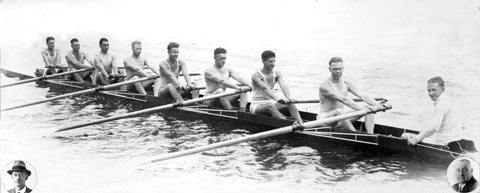
Sydney Champion eight of 1934
H Gilmour, W Dixon, R Crebbin, F Pike, F Lester, T Nickson, G May, J Goulding (stroke), M Napier (cox), Insets: E Keary (coach), G Hilder (trainer)
Problems were in store, however: Keary, the coach, sought a change in the crew and Williams refused. Keary resigned. A special RA meeting was held and it confirmed Keary's power to make any alteration within his squad he deemed fit. Williams thereupon resigned, although he was later prevailed upon to withdraw his resignation. Jordan was brought back into the crew and Schmitzer became emergency.
The location of the race in Tasmania had also caused considerable controversy. The TRA chose the Derwent, although NSW preferred the more reliable Huon. In training on the course, the work of the interstate crews was hampered by the rough conditions and the Victorian eight actually swamped and its boat was damaged beyond repair. The race itself "proved conclusively and definitely for all time that the Derwent is not suitable for so important a race". With the wind coming in from the sea, there was a strong head-wind over the whole course and the further the crews went, the rougher it got.
Victoria led early, but their boat gradually filled and sank after two miles. NSW took the lead after the mile and rowed cleanly and neatly to win from WA by 4 lengths. SA also swamped. The time for the race was 19.38.5, compared to the 1933 record of 14.30.
Conditions were better in the sculls, which Turner won by 15 lengths from Beauchamp, the Tasmanian. (With NSW on top, it was unfortunate that no rowing events were set down for the 1934 Empire Games in London.) The five years of the "sole selector" scheme in NSW had now yielded three wins and two seconds in the eights and five wins in a row in the sculls.
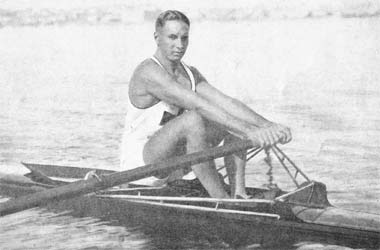
Herbert Turner
The 1934/35 season was also noteworthy, especially in Victoria. This was because London Rowing Club, winners of the Grand at Royal Henley in 1933, accepted an invitation to row at Henley-on-Yarra. Crews from 39 clubs, 17 of which were outside Victoria, took part in the regatta, which celebrated the 100th anniversary of the State's foundation.
Over 100,000 people saw the 53 races, all rowed between 12:15 and 4:50 p.m. - as one race finished, crews in the next came around the bend. Sydney's eight had planned to compete but problems arose in obtaining leave. The London oarsmen duly triumphed in the Grand Challenge Cup, beating Wanganui of NZ in the final by 3 lengths.
Turner, now rowing with Police, met and defeated the NZ champion in the sculls for his third successive win (the coach of the London crew sank ingloriously in his heat of the sculls). In the Victorian champion eights, rowed a week later, London won by 8 lengths. The Wanganui crew, but not the Englishmen, visited NSW as well and competed for the specially-presented "Kerr Cup" at the SRC regatta. The NZ crew won with Mosman second and Sydney third. The Mosman crew, which contained four members of the previous year's Shore eight, went on to win the State championship, although Police pushed them to a 4 feet decision.
Turner and Hoskins retained their respective sculling titles, while Sydney, stroked by Ossie Rosevear, secured the lightweight fours title and, later, the lightweight eights championship as well. At the first-ever Police regatta, the one Sydney crew won both the maiden and junior eights. It was boated Norm Grounds (bow), John Nicholls, Des Hughes, Cliff Ebsworth, Dave Murray-Prior, Brian Barker, Doug Bain, Norm Simpson (stroke) and Tony Nickson (cox).
NSW won the King's Cup for the third time in a row. Only Bromley, Dixon and Jordan of the 1934 eight were available for selection and they were supplemented by four Police oarsmen and one from Haberfield. George MacKenzie, now coaching Police, was appointed coach. The Nepean River was the site of the King's Cup carnival in 1935 and ideal conditions prevailed for the regatta. In the main race, WA led for much of the way but NSW got to the lead at the two mile mark and held off repeated challenges from WA to win by 2/3 of a length and record the hat trick. SA was third, 4 lengths back. In the sculls, Turner again showed his superiority by beating Peppler of Victoria by some 30 lengths.
The forthcoming Olympic Games in Berlin were not far from the thoughts of oarsmen in the 1935/36 season. It was the Police crew, however, which was to enjoy most success. Police won all the preliminary senior eight events, including the Grand at Henley-on-Yarra by 4 lengths and, in the champion eights, beat Sydney by a further 4 lengths. Turner had won the Henley-on-Yarra sculls "as usual" but was beaten by Cec Pearce of Balmain in the championship.
The Police club now announced its intention of finding the finance to send its crew to the Games. The three Australian selectors, Williams, Kenny and Ryan, agreed to recommend the Police crew and the NSWRA co-operated by deciding to select a crew for the King's Cup without drawing on the Police eight.
The NSW crew selected by Williams included Dixon and Bromley again plus the four ex-Shore men of Mosman and one each from University and Police. (The selections left Sydney's seniors almost in tact and the club gained some consolation from a win in the 50th Jubilee Gold Cup event. The crew involved was Ebsworth (bow), Nicholls, Groom, Wise, Bain, Watt, Atkins and Simpson (stroke).) The King's Cup was rowed in Perth and NSW, albeit a "second" crew, won again. They beat SA by 3 lengths, with WA third.
Pearce continued the NSW domination of the sculling race.
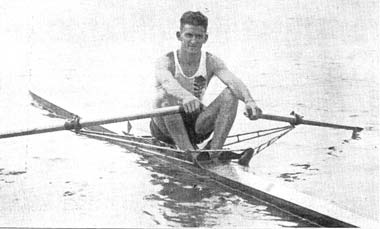
Cec Pearce
Australia was well represented in the rowing events at the 1936 Olympics. The Police eight duly gained selection, the crew being Bill Cross (bow), Don Fergusson, Len Einsaar, George Elias, Mervyn Wood, Wal Jordan, Joe Gould and Wal Mackney (stroke), with Norm Ella cox and MacKenzie coach. Pearce defeated Turner in a test race over 2000 meters to gain selection as a sculler while Dixon and Turner were added to the squad as emergencies and entered for the double sculls (despite the fact that Dixon had never sculled in Australia).
In training at Berlin, Pearce proved very impressive and he was hailed as an almost certain winner. On the day of his heat, however, he had a severe cold and finished only fourth. In the repechage, he came second and was eliminated, the final being won by Schaefer of Germany.
The eight did not go well and finished fourth in its heat, behind Hungary, Italy and Canada. It too failed to qualify through the repechages for the final which was won by USA, with Italy second and Germany third. The best result came from the emergencies. They also came fourth in the heat but won the repechage and entered the final, there to finish sixth in a race won by Great Britain.
Back in Australia, Harry Alderson, who had earned much praise for his work as manager of the whole Australian Olympic team, suggested that a single club crew representing Australia was not ideal, as only the best Australia could produce would have a chance in Olympic competition.
North Shore surprised by doing very well in the 1936/37 season. Their eight, coached by Doug Bowden, won several senior eight events, including the Grand Challenge Cup at Henley-on-Yarra. In the champion eights, however, they were beaten by both Mosman and Sydney, with Police finishing only fourth. The Sydney crew, beaten by 1 1/2 lengths, was boated Boulton (bow), Ebsworth, Kennedy, Watt, Wise, Dixon, Bain and Elias (stroke).
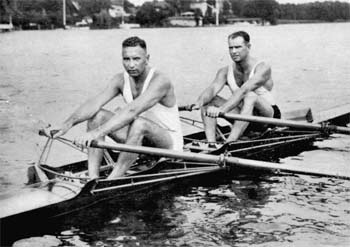
Turner and Dixon
Pearce scored a clear win in the sculls over Bill Bradley of Sydney, the 1936 Henley-on-Yarra winner. A Sydney junior four was, meanwhile, having a string of wins. It comprised D. Bennett (bow), Norm Grounds, Jock Boulton and Dave Elias (stroke) with Bill Kerr cox and Norm Pottie coach. Sydney also secured the lightweight champion eights once again, the crew being Stan Dale (bow), Norm Grounds, Eric Perry, Ossie Rosevear, Bill Court, Bill Heyde, Jock Boulton and Dave Elias (stroke) with Bill Kerr cox and Staunton Hoskins coach.
Bernie Williams retained his role as sole State selector and his final choice fell on Dixon and Elias of Sydney, Thomas and Buckham of Mosman, Wood and Elias of Police and Moody and Grace of North Shore. Burrell was initially selected as stroke but dropped out through injury at a late stage. Bowden was cox and Raper coach. The NSW eight proved unimpressive early but improved a great deal at Murray Bridge before the race itself. They had to be content with second, finishing a length behind SA and 3/4 length in front of WA. Pearce scored an easy win in the sculls.
Preparations were quickly underway for the rowing events for the 1938 British Empire Games to be held in Sydney in February. It was decided to conduct the events on the Nepean and Ernie Keary was appointed sole selector of the Australian crews. He went to work immediately and soon named a squad of 26 in which each State was represented. The crews were finalised immediately after Henley-on-Yarra at the end of November. (Police won the Grand Challenge title for NSW once again while Turner beat Pearce in the final of the sculls.)
Keary selected four from NSW in the eight - Thomas, Bromley, Dixon and Gould - along with three from WA and one from SA. The latter, Gregory, had represented SA since 1932, while the West Australians, Le Souef, Yewers and Paramor, were all King's Cup representatives. In the four was Fisher of NSW, two more from WA (including the budding politician Gordon Freeth), and a Victorian. A Tasmanian, a Queenslander and two more Victorians comprised the emergencies. Bowden and Bill Kerr of NSW were nominated as coxswains of the eight and four respectively, with Keary himself coaching the eight and T.K. ("Toff") Qurban of SA coaching the four.
A test race was ordered for the sculls, with Turner finishing strongly to defeat Pearce by 2/3 length. The team assembled at Sydney Rowing Club at the end of December and began their preparation, excellent combinations soon developing.
Great interest soon centred on the visiting crews from England, Canada and NZ. At a late stage, the English crew surprised by adding Tim Turner, a member of the London eight who had remained in Australia, to the squad. Despite his limited rowing in Australia, he was later made stroke.
For Australia, Keary was forced to drop out as coach due to ill-health and was replaced by Sid Raper, who supervised the final training at Penrith. The Empire Games rowing proved very successful for Australia, with two wins and a second in the three official events. The second was, unfortunately, in the eights in which, despite leading for much of the way, Julius Beresford's English crew rowed past Australia to win by 3/4 length with NZ 2 lengths back third. The four won by 1 1/4 lengths from NZ with Canada third, while Turner had an easy win. An invitation double sculls was also held, with Bradley and Pearce representing Australia and, rowing in very impressive fashion, beating England by 9 lengths with NZ third. All races were rowed over 1 1/4 miles.
The 1937/38 rowing season in Sydney was, meanwhile, continuing. North Shore stood out in senior events and won the championship by 4 lengths, with Pittwater beating Sydney into third place. Fred Smith, of the Pittwater eight, was no less than 54 years of age. Cec Pearce beat his only opponent, Bill Stevenson of Balmain, by 1/4 mile, while Hoskins won the lightweight sculls for the fourth time. Sydney later retained the lightweight eights title.
Bernie Williams had been appointed sole NSW selector for the sixth time, but he died in October, 1937. A former Leichhardt and Mercantile (SA) oarsman, he had had an extraordinarily successful career as coach and selector. Cliff Lambert, captain of SRC, was appointed in his place. Lambert chose Dixon and Gould of the Empire Games crew (Thomas and Bromley had retired) together with Grace, Willis and Myers of North Shore, Bradley and Bain of Sydney and Wood of Police. For Dixon it was to be the sixth successive King's Cup, not to mention the Olympics and the Empire Games. Bowden was coach and Kerr cox.
The crew went well in training and was favoured for the big race in Melbourne. They led until the last 80 yards, when a strong finish by WA took them past NSW to win by a canvas. Tasmania, coached initially by Ernie Keary, was 4 lengths back third. Cec Pearce won the sculls by no less than 70 lengths.
The 1938/39 season opened with the promise of another special occasion: the Henley Royal Regatta committee invited an eight, from Australia to compete at the centennial regatta in July, 1939. It was Haberfield, coached by Dr. Parkes, which stood out in the new season's events. The club's crews won the champion fours of NSW and several senior eights. Turner won the Henley-on-Yarra sculls for the sixth time, with Haberfield second in the final of the Grand and Police winning the Stewards' fours.
A hurricane was to cause postponement of the SRC regatta as well as the sinking of five pontoons and the near blowing over of Drummyone's boatshed. Haberfield's success continued and they won the champion eights, but only by a length from the light Pittwater crew. Sydney lost a number of men through illness and did poorly. Pearce, who had been having considerable rowing success with Balmain crews, won the sculls by 20 lengths from Turner and Bradley.
Raper was appointed to select both the Royal Henley and the King's Cup crews. Fourteen oarsmen offered to subscribe ₤50 each to help meet the heavy Henley expenses and the crew finally selected included Bill Dixon, Brin Jay, James Barnes and Tom Chessell (cox) of Sydney, Macpherson, Trebeck and Grace of North Shore, and Bromley, Burrell and Gordon-Glassford (emergency) of Mosman. John Rook was appointed manager while Julius Beresford and his son Jack agreed to coach the crew in England. (There was some criticism of the crew as lacking rowing experience in some seats: Jay, for example, was a member of Shore's 1938 eight and had done no club rowing.)
All non-SRC members of the crew were made honorary members and the eight competed at Henley as Sydney Rowing Club once again. In the heat of the big event, the crew recorded a narrow win over Kingston, but they were beaten by 3 lengths by Argonaut in the semi-final. In the final, Harvard University scored an easy win over the Canadians. Turner was eliminated by Verey of Poland in his heat, with Joe Burk of the USA defeating Verey in the final.
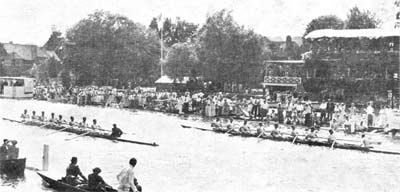
The Sydney eight being beaten by Argonaut at the 1939 Henley Royal Regatta
The NSW King's Cup eight, meanwhile, had been selected and included six Haberfield men and two Police oarsmen, with Dr. Parkes coach. WA failed to defend its title in the race in Brisbane and the locals ran out the winners in a new record time, 1 3/4 lengths ahead of NSW with SA third. Victoria would have finished second but was disqualified for failing to round a buoy. Pearce had an easy win, also setting a new record for the course.
